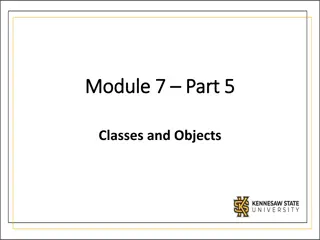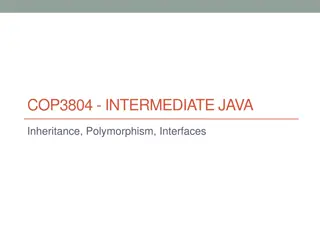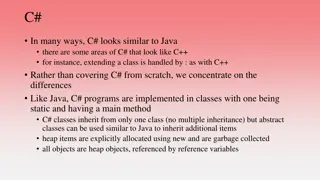Understanding Abstract Classes and Inheritance in Java
Explore how to utilize abstract classes and inheritance in Java programming to share common code across classes. Learn through examples involving animals like Dillo and Boa, and discover the concept of creating helper methods and abstract classes to abstract common features efficiently.
Download Presentation

Please find below an Image/Link to download the presentation.
The content on the website is provided AS IS for your information and personal use only. It may not be sold, licensed, or shared on other websites without obtaining consent from the author. Download presentation by click this link. If you encounter any issues during the download, it is possible that the publisher has removed the file from their server.
E N D
Presentation Transcript
CS2102: Lecture on Abstract Classes and Inheritance Kathi Fisler
How to Use These Slides These slides walk you through how to share common code (i.e., create helper methods) across classes I recommend you download the starter file (posted to the website) and make the edits in the slides, step by step, to see what happens for yourself In the slides, green highlights what changed in the code from the previous slide; yellow highlights show Java compile errors Note any questions, and ask on the board or in the lecture-time chat
Back to the Animals (code we had last week) interface IAnimal { // determine whether animal's length // is within normal boundaries boolean isNormalSize(); } Notice the almost identical code class Dillo implements IAnimal { int length; boolean isDead; class Boa implements IAnimal { int length; String eats; Dillo(int length, boolean isDead) { this.length = length; this.isDead = isDead; } Boa(int length, String eats) { this.length = length; this.eats = eats; } // determine whether this dillo's // length is between 2 and 3 public boolean isNormalSize () { return 2 <= this.length && this.length <= 3 ; } // determine whether this boa's // length is between 5 and 10 public boolean isNormalSize () { return 5 <= this.length && this.length <= 10 ; } } }
We should create a helper method, but where can we put it? (remember, all methods must be in a class) interface IAnimal { // determine whether animal's length // is within normal boundaries boolean isNormalSize(); } Notice the almost identical code class Dillo implements IAnimal { int length; boolean isDead; Dillo(int length, boolean isDead) { this.length = length; this.isDead = isDead; } // determine whether this dillo's // length is between 2 and 3 public boolean isNormalSize () { return 2 <= this.length && this.length <= 3 ; } } class Boa implements IAnimal { int length; String eats; Boa(int length, String eats) { this.length = length; this.eats = eats; } // determine whether this boa's // length is between 5 and 10 public boolean isNormalSize () { return 5 <= this.length && this.length <= 10 ; } }
We will create a new class that abstracts over the common features of Dillo and Boa. class AbsAnimal { interface IAnimal { // determine whether animal's length // is within normal boundaries boolean isNormalSize(); } ( abs for abstract) We ll call the new class AbsAnimal } class Dillo implements IAnimal { int length; boolean isDead; Dillo(int length, boolean isDead) { this.length = length; this.isDead = isDead; } // determine whether this dillo's // length is between 2 and 3 public boolean isNormalSize () { return 2 <= this.length && this.length <= 3 ; } } class Boa implements IAnimal { int length; String eats; Boa(int length, String eats) { this.length = length; this.eats = eats; } // determine whether this boa's // length is between 5 and 10 public boolean isNormalSize () { return 5 <= this.length && this.length <= 10 ; } }
We will put a helper method for isNormalSize in AbsAnimal. class AbsAnimal { // determine whether animal s // length is between low and high boolean isLenWithin (int low, int high) { return low <= this.length && this.length <= high ; } } We call the helper isLenWithin; it takes the varying low and high values as interface IAnimal { // determine whether animal's length // is within normal boundaries boolean isNormalSize(); } inputs (but otherwise copies the common code, as usual when making a helper) class Dillo implements IAnimal { int length; boolean isDead; Dillo(int length, boolean isDead) { this.length = length; this.isDead = isDead; } // determine whether this dillo's // length is between 2 and 3 public boolean isNormalSize () { return 2 <= this.length && this.length <= 3 ; } } class Boa implements IAnimal { int length; String eats; Boa(int length, String eats) { this.length = length; this.eats = eats; } // determine whether this boa's // length is between 5 and 10 public boolean isNormalSize () { return 5 <= this.length && this.length <= 10 ; } }
Next, we rewrite the original isNormalSize methods to call the helper method class AbsAnimal { // determine whether animal s // length is between low and high boolean isLenWithin (int low, int high) { return low <= this.length && this.length <= high ; } } interface IAnimal { // determine whether animal's length // is within normal boundaries boolean isNormalSize(); } class Dillo implements IAnimal { int length; boolean isDead; Dillo(int length, boolean isDead) { this.length = length; this.isDead = isDead; } // determine whether this dillo's // length is between 2 and 3 public boolean isNormalSize () { return isLenWithin(2,3); } } class Boa implements IAnimal { int length; String eats; Boa(int length, String eats) { this.length = length; this.eats = eats; } // determine whether this boa's // length is between 5 and 10 public boolean isNormalSize () { return isLenWithin(5,10); } }
This is the right idea, but if we compile the Dillo and Boa classes, Java will complain that isLenWithinisn t defined. class AbsAnimal { // determine whether animal s // length is between low and high boolean isLenWithin (int low, int high) { return low <= this.length && this.length <= high ; } } interface IAnimal { // determine whether animal's length // is within normal boundaries boolean isNormalSize(); } class Dillo implements IAnimal { int length; boolean isDead; Dillo(int length, boolean isDead) { this.length = length; this.isDead = isDead; } // determine whether this dillo's // length is between 2 and 3 public boolean isNormalSize () { return isLenWithin(2,3); } } class Boa implements IAnimal { int length; String eats; Boa(int length, String eats) { this.length = length; this.eats = eats; } // determine whether this boa's // length is between 5 and 10 public boolean isNormalSize () { return isLenWithin(5,10); } }
This is the right idea, but if we compile the Dillo and Boa classes, Java will complain that isLenWithinisn t defined. class AbsAnimal { // determine whether animal s // length is between low and high boolean isLenWithin (int low, int high) { return low <= this.length && this.length <= high ; } } interface IAnimal { // determine whether animal's length // is within normal boundaries boolean isNormalSize(); } connected Dillo and Boa to AbsAnimal. The problem is that we never class Dillo implements IAnimal { int length; boolean isDead; Dillo(int length, boolean isDead) { this.length = length; this.isDead = isDead; } // determine whether this dillo's // length is between 2 and 3 public boolean isNormalSize () { return isLenWithin(2,3); } } class Boa implements IAnimal { int length; String eats; Boa(int length, String eats) { this.length = length; this.eats = eats; } // determine whether this boa's // length is between 5 and 10 public boolean isNormalSize () { return isLenWithin(5,10); } }
We connect Dillo and Boa to AbsAnimal using a new Java keyword, extends, which says that one class (Dillo/Boa) includes the content of another (AbsAnimal) class AbsAnimal { // determine whether animal s // length is between low and high boolean isLenWithin (int low, int high) { return low <= this.length && this.length <= high ; } } interface IAnimal { // determine whether animal's length // is within normal boundaries boolean isNormalSize(); } class Dillo extends AbsAnimal implements IAnimal { int length; boolean isDead; Dillo(int length, boolean isDead) { this.length = length; this.isDead = isDead; } // determine whether this dillo's // length is between 2 and 3 public boolean isNormalSize () { return isLenWithin(2,3); } } class Boa extends AbsAnimal implements IAnimal { int length; String eats; Boa(int length, String eats) { this.length = length; this.eats = eats; } // determine whether this boa's // length is between 5 and 10 public boolean isNormalSize () { return isLenWithin(5,10); } }
Now, AbsAnimalwont compile; Java will say that it doesn t have a length variable. class AbsAnimal { // determine whether animal s // length is between low and high boolean isLenWithin (int low, int high) { return low <= this.length && this.length <= high ; } } interface IAnimal { // determine whether animal's length // is within normal boundaries boolean isNormalSize(); } class Dillo extends AbsAnimal implements IAnimal { int length; boolean isDead; Dillo(int length, boolean isDead) { this.length = length; this.isDead = isDead; } // determine whether this dillo's // length is between 2 and 3 public boolean isNormalSize () { return isLenWithin(2,3); } } class Boa extends AbsAnimal implements IAnimal { int length; String eats; Boa(int length, String eats) { this.length = length; this.eats = eats; } // determine whether this boa's // length is between 5 and 10 public boolean isNormalSize () { return isLenWithin(5,10); } }
Now, AbsAnimalwont compile; Java will say that it doesn t have a length variable. class AbsAnimal { // determine whether animal s // length is between low and high boolean isLenWithin (int low, int high) { return low <= this.length && this.length <= high ; } } interface IAnimal { // determine whether animal's length // is within normal boundaries boolean isNormalSize(); } Dillo and Boa. It should also have moved to AbsAnimal But note that the length variable is also common to class Dillo extends AbsAnimal implements IAnimal { int length; boolean isDead; Dillo(int length, boolean isDead) { this.length = length; this.isDead = isDead; } // determine whether this dillo's // length is between 2 and 3 public boolean isNormalSize () { return isLenWithin(2,3); } } class Boa extends AbsAnimal implements IAnimal { int length; String eats; Boa(int length, String eats) { this.length = length; this.eats = eats; } // determine whether this boa's // length is between 5 and 10 public boolean isNormalSize () { return isLenWithin(5,10); } }
Now, AbsAnimalwont compile; Java will say that it doesn t have a length variable. class AbsAnimal { int length; // determine whether animal s // length is between low and high boolean isLenWithin (int low, int high) { return low <= this.length && this.length <= high ; } } interface IAnimal { // determine whether animal's length // is within normal boundaries boolean isNormalSize(); } Dillo and Boa. It should also have moved to AbsAnimal But note that the length variable is also common to class Dillo extends AbsAnimal implements IAnimal { int length; boolean isDead; Dillo(int length, boolean isDead) { this.length = length; this.isDead = isDead; } // determine whether this dillo's // length is between 2 and 3 public boolean isNormalSize () { return isLenWithin(2,3); } } class Boa extends AbsAnimal implements IAnimal { int length; String eats; Boa(int length, String eats) { this.length = length; this.eats = eats; } // determine whether this boa's // length is between 5 and 10 public boolean isNormalSize () { return isLenWithin(5,10); } }
We need to add a constructor to AbsAnimal, and have it set the value of length class AbsAnimal { int length; // constructor AbsAnimal(int length) { this.length = length; } interface IAnimal { // determine whether animal's length // is within normal boundaries boolean isNormalSize(); } apply to Boa as well)] [For sake of space, we will hide the Boa class (edits to Dillo // determine whether animal s // length is between low and high boolean isLenWithin (int low, int high) { return low <= this.length && this.length <= high ; } } class Dillo extends AbsAnimal implements IAnimal { boolean isDead; Dillo(int length, boolean isDead) { this.length = length; this.isDead = isDead; } // determine whether this dillo's // length is between 2 and 3 public boolean isNormalSize () { return isLenWithin(2,3); } } Notice that we removed the length variable from Dillo
We need to add a constructor to AbsAnimal, and have it set the value of length class AbsAnimal { int length; // constructor AbsAnimal(int length) { this.length = length; } interface IAnimal { // determine whether animal's length // is within normal boundaries boolean isNormalSize(); } // determine whether animal s // length is between low and high boolean isLenWithin (int low, int high) { return low <= this.length && this.length <= high ; } } class Dillo extends AbsAnimal implements IAnimal { boolean isDead; Dillo(int length, boolean isDead) { super(length); this.isDead = isDead; } // determine whether this dillo's // length is between 2 and 3 public boolean isNormalSize () { return isLenWithin(2,3); } } Notice that we removed the length variable from Dillo The Dillo constructor needs to send the length value to the AbsAnimal constructor
In Java, super refers to the constructor for the class that this class extends; inside Dillo, super calls the AbsAnimal constructor. class AbsAnimal { int length; // constructor AbsAnimal(int length) { this.length = length; } interface IAnimal { // determine whether animal's length // is within normal boundaries boolean isNormalSize(); } // determine whether animal s // length is between low and high boolean isLenWithin (int low, int high) { return low <= this.length && this.length <= high ; } } class Dillo extends AbsAnimal implements IAnimal { boolean isDead; Dillo(int length, boolean isDead) { super(length); this.isDead = isDead; } // determine whether this dillo's // length is between 2 and 3 public boolean isNormalSize () { return isLenWithin(2,3); } } Notice that we removed the length variable from Dillo The Dillo constructor needs to send the length value to the AbsAnimal constructor
In Java, super refers to the constructor for the class that this class extends; inside Dillo, super calls the AbsAnimal constructor. class AbsAnimal { int length; // constructor AbsAnimal(int length) { this.length = length; } interface IAnimal { // determine whether animal's length // is within normal boundaries boolean isNormalSize(); } // determine whether animal s // length is between low and high boolean isLenWithin (int low, int high) { return low <= this.length && this.length <= high ; } } class Dillo extends AbsAnimal implements IAnimal { boolean isDead; Dillo(int length, boolean isDead) { super(length); this.isDead = isDead; } // determine whether this dillo's // length is between 2 and 3 public boolean isNormalSize () { return isLenWithin(2,3); } } Whenever a class extends another class, its constructor should call super before doing anything else (i.e., the call to super should be the first statement in the method)
Almost done. Since Dillo and Boa both implement IAnimal, we can move that to AbsAnimal as well class AbsAnimal implements IAnimal { int length; // constructor AbsAnimal(int length) { this.length = length; } interface IAnimal { // determine whether animal's length // is within normal boundaries boolean isNormalSize(); } // determine whether animal s // length is between low and high boolean isLenWithin (int low, int high) { return low <= this.length && this.length <= high ; } } class Dillo extends AbsAnimal implements IAnimal { boolean isDead; Dillo(int length, boolean isDead) { super(length); this.isDead = isDead; } // determine whether this dillo's // length is between 2 and 3 public boolean isNormalSize () { return isLenWithin(2,3); } }
Heres the final code class AbsAnimal implements IAnimal { int length; // constructor AbsAnimal(int length) { this.length = length; } interface IAnimal { // determine whether animal's length // is within normal boundaries boolean isNormalSize(); } // determine whether animal s // length is between low and high boolean isLenWithin (int low, int high) { return low <= this.length && this.length <= high ; } } class Dillo extends AbsAnimal { boolean isDead; Dillo(int length, boolean isDead) { super(length); this.isDead = isDead; } // determine whether this dillo's // length is between 2 and 3 public boolean isNormalSize () { return isLenWithin(2,3); } } class Boa extends AbsAnimal { String eats; Boa(int length, String eats) { super(length); this.eats = eats; } // determine whether this boa's // length is between 5 and 10 public boolean isNormalSize () { return isLenWithin(5,10); } }
Recap so far When multiple classes need to share code (such as a helper method), put that code in a (parent) class that the sharing classes each extends Common variables and implements statements also move to the parent class If a class extends another class, its constructor should call super (to properly set up the contents of the superclass) Classes can use all variables and methods in their superclass
Facts about Extends Terminology: If class A extends class B, then (1) B is the superclass of A; (2) A is a subclass of B; (3) A is also said to inherit from B Restrictions: A class may have at most one superclass (ie, only extends one class), but arbitrarily many subclasses. [In contrast, a class can implement arbitrarily many interfaces.] Behavior: A class has access to all variables and methods of its superclass (there are exceptions, but we will discuss those later) Behavior: A class cannot access the variables or methods of its subclasses
BUT THERE ARE STILL SOME ISSUES TO ADDRESS
What if someone writes new AbsAnimal(8)? class AbsAnimal implements IAnimal { int length; // constructor AbsAnimal(int length) { this.length = length; } What kind of animal does this yield? interface IAnimal { // determine whether animal's length // is within normal boundaries boolean isNormalSize(); } // determine whether animal s // length is between low and high boolean isLenWithin (int low, int high) { return low <= this.length && this.length <= high ; } } class Dillo extends AbsAnimal { boolean isDead; Dillo(int length, boolean isDead) { super(length); this.isDead = isDead; } // determine whether this dillo's // length is between 2 and 3 public boolean isNormalSize () { return isLenWithin(2,3); } } class Boa extends AbsAnimal { String eats; Boa(int length, String eats) { super(length); this.eats = eats; } // determine whether this boa's // length is between 5 and 10 public boolean isNormalSize () { return isLenWithin(5,10); } }
What if someone writes new AbsAnimal(8)? class AbsAnimal implements IAnimal { int length; // constructor AbsAnimal(int length) { this.length = length; } What kind of animal does this yield? interface IAnimal { // determine whether animal's length // is within normal boundaries boolean isNormalSize(); } It doesn t yield any known (or meaningful) kind of animal. AbsAnimal is only meant to hold code, it shouldn t be used to create objects. // determine whether animal s // length is between low and high boolean isLenWithin (int low, int high) { return low <= this.length && this.length <= high ; } } class Dillo extends AbsAnimal { boolean isDead; Dillo(int length, boolean isDead) { super(length); this.isDead = isDead; } // determine whether this dillo's // length is between 2 and 3 public boolean isNormalSize () { return isLenWithin(2,3); } } class Boa extends AbsAnimal { String eats; Boa(int length, String eats) { super(length); this.eats = eats; } // determine whether this boa's // length is between 5 and 10 public boolean isNormalSize () { return isLenWithin(5,10); } } We d like to tell Java not to let anyone create objects from AbsAnimal
To tell Java not to let anyone create objects from a class, we annotate the class with the keyword abstract abstract class AbsAnimal implements IAnimal { int length; // constructor AbsAnimal(int length) { this.length = length; } interface IAnimal { // determine whether animal's length // is within normal boundaries boolean isNormalSize(); } new AbsAnimal(8) would raise a Java error Now, the expression // determine whether animal s // length is between low and high boolean isLenWithin (int low, int high) { return low <= this.length && this.length <= high ; } } class Dillo extends AbsAnimal { boolean isDead; Dillo(int length, boolean isDead) { super(length); this.isDead = isDead; } // determine whether this dillo's // length is between 2 and 3 public boolean isNormalSize () { return isLenWithin(2,3); } } Rule of thumb: if a class only to hold common code, make it abstract class Boa extends AbsAnimal { String eats; Boa(int length, String eats) { super(length); this.eats = eats; } // determine whether this boa's // length is between 5 and 10 public boolean isNormalSize () { return isLenWithin(5,10); } }
WHY DO WE NEED BOTH AN INTERFACE AND AN ABSTRACT CLASS?
abstract class AbsAnimal implements IAnimal { int length; interface IAnimal { // determine whether animal's length // is within normal boundaries boolean isNormalSize(); } // constructor AbsAnimal(int length) { this.length = length; } Interfaces and abstract classes serve two very different purposes // determine whether animal s // length is between low and high boolean isLenWithin (int low, int high) { return low <= this.length && this.length <= high ; } } Interfaces are a form of types: they capture what a class must do, but they do not constrain how the class does something. As such, interfaces cannot contain code (beyond method input/output types) or variables Abstract classes are for sharing (abstracting over) data and code across multiple classes; they constrain how extending classes organize and use data Both roles are important, so OO programs often use both
abstract class AbsAnimal implements IAnimal { int length; interface IAnimal { // determine whether animal's length // is within normal boundaries boolean isNormalSize(); } // constructor AbsAnimal(int length) { this.length = length; } Interfaces and abstract classes serve two very different purposes // determine whether animal s // length is between low and high boolean isLenWithin (int low, int high) { return low <= this.length && this.length <= high ; } } Imagine that we wanted to add fruit flies to our data. They are too small to have a length. Having IAnimal lets us write isNormalSize (to always return true) without having to specify a meaningless length value for a fruit fly. If you already know some Java, you may have been taught to overuse class extension instead of interfaces. Interfaces are proper OO design practice (more on this through 2102)
What you should be able to do now Use extends to share code among classes Use super in constructors Make a class abstract to prevent someone from creating objects from it Choose between using interfaces and (abstract) classes when designing programs
Some Study Questions Why didn t we put isLenWithin in IAnimal? Can AbsAnimal refer to the eats variable of Boa? Could we have defined isNormalSize directly inside of AbsAnimal, instead of writing isLenWithin? If so, how? If we wanted to write a doesEatTofu method on Boa, which class should it go into? Should it be mentioned in IAnimal?
Experiments to Try on the Code Edit the posted starter file with the code from these notes, then experiment with the following: What error does Java give if you try to extend an interface or implement an abstract class? What error does Java give if you try to access a subclass variable in a superclass? If you forgot to delete the int length line from the Dillo class (after adding it to AbsAnimal), what would Java do?























